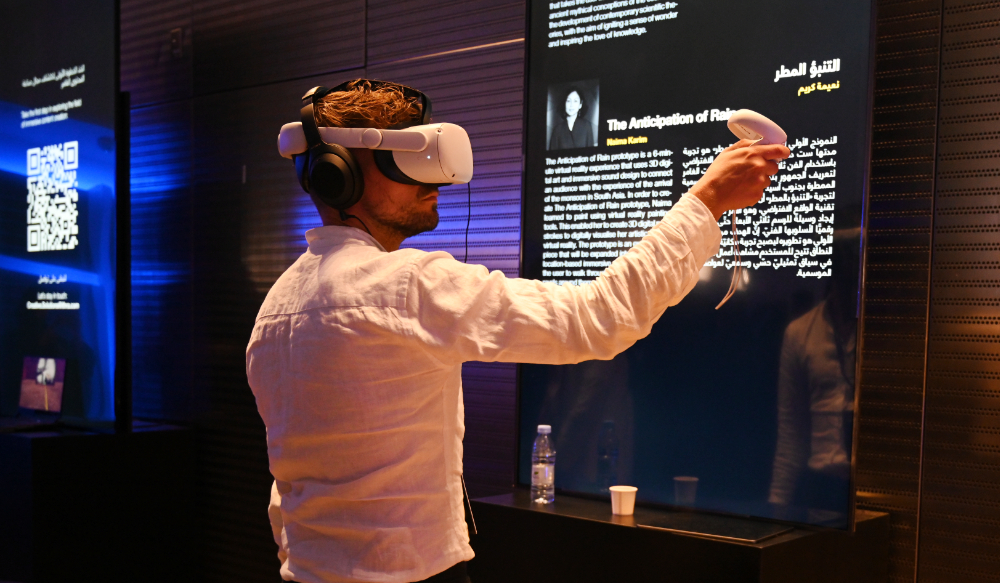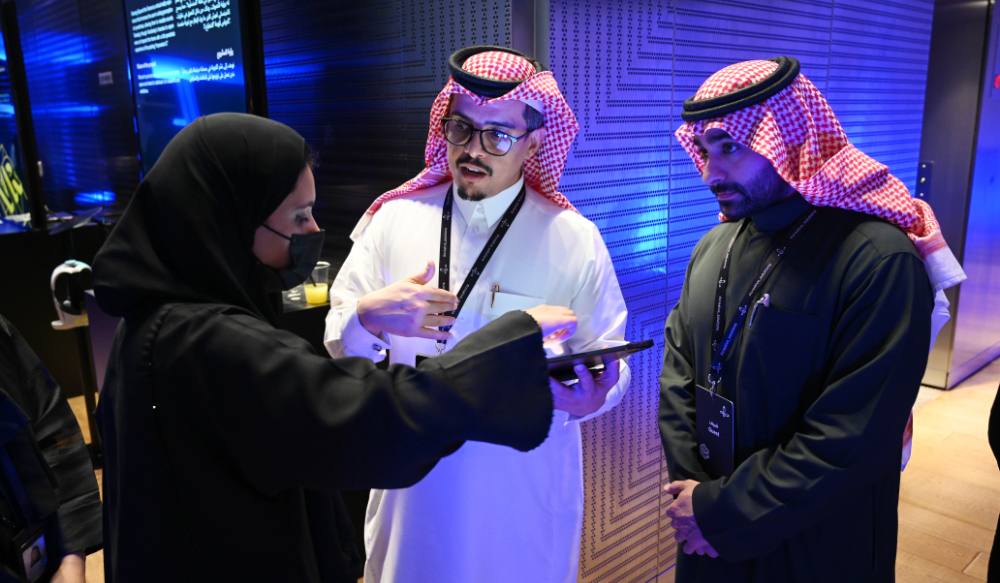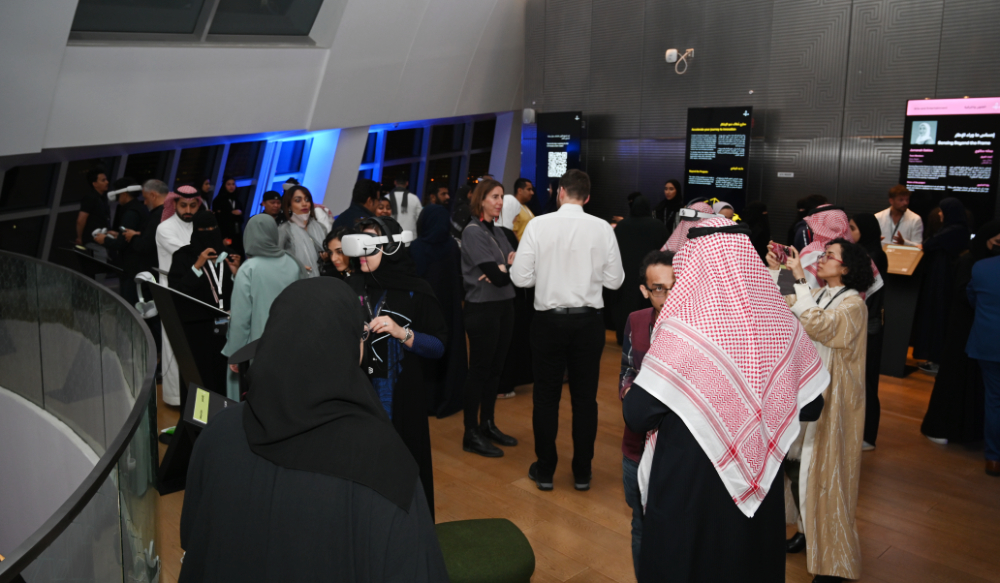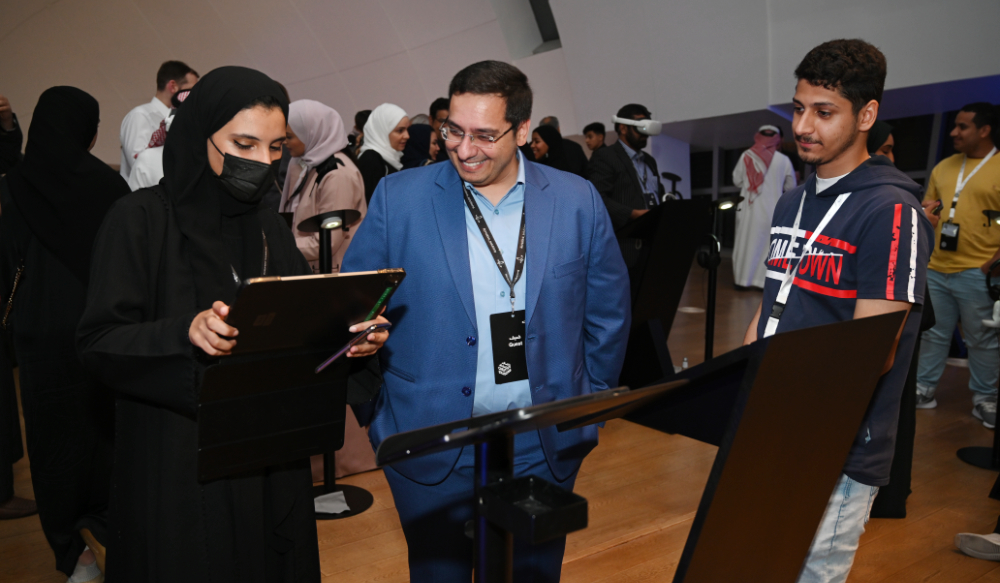DHAHRAN: The third edition of the King Abdulaziz Center for World Culture’s (Ithra) Creative Solutions initiative aims to enter the metaverse with its immersive digital technologies.
The year-long project has been designed to boost Saudi Arabia’s creative economy by empowering digital content creation in immersive technologies.
Each project is required to develop and deploy an immersive component by using virtual reality, augmented reality, extended reality, haptics, or immersive audio.
It comes with a grant of SR375,000 ($100,000).
The Creative Solutions program is open to all citizens and residents of Saudi Arabia aged over 18.
Organizers hope the program will provide focused learning for innovators and creatives by redefining the way communities build on the creative and technology-based economy, with an emphasis on science, technology, engineering, art and architecture, and mathematics, the arts, and self-development.

On Feb. 1 Ithra presented its 2022 cycle demo day titled, ‘Accelerate Your Journey to Innovation’ which showcased the 10 finalist projects. (Supplied)
Proposal submissions for this year’s Creative Solutions cycle three cohort are open until April 13.
To sign up for round three and for more information on Ithra and its programs, visit ithra.com or the center’s social media channels.
Miznah Alzamil, head of creativity and innovation at Ithra, told Arab News: “What’s coming up is another great program, from the very beginning. We’ve seen the progress in terms of submitting and the quality of ideas from first year to second year.

On Feb. 1 Ithra presented its 2022 cycle demo day titled, ‘Accelerate Your Journey to Innovation’ which showcased the 10 finalist projects. (Supplied)
“Immersive technologies have transformed how we work, play, and communicate. We are proud of our program participants’ contributions and excited to unveil their innovative products.
NUMBER
$100k
The 3rd Creative Solutions initiative grant amounts to SR375,000 ($100,000).
“The top proposals that made it to prototype stage demonstrate the spirit of innovative thinking driving the creative economy forward and propelling us further into a future guided by the Kingdom’s talent. This truly is a global showcase of Saudi innovation,” she said.
Launched in 2021, the program, headquartered at Ithra’s landmark Dhahran building, registered an astonishing 2,062 projects.
The Creative Solutions team managed to narrow that number down to 30.

On Feb. 1 Ithra presented its 2022 cycle demo day titled, ‘Accelerate Your Journey to Innovation’ which showcased the 10 finalist projects. (Supplied)
In 2022, 845 projects were considered and only 15 were selected to move to the next round.
Last year’s group saw more than 400 hours of training compared to 254 the first time around. Both cycles had 14 masterclasses.
Alums of the program were selected from hundreds of proposals by an international panel of judges, led by Bafta- and Emmy-winning immersive storyteller Kim-Leigh Pontin of Marvel’s Eternals AR adventure, and Anne McKinnon, the co-founder and chief executive officer of metaverse platform Ristband.
HIGHLIGHTS
• Creative Solutions begins its 3rd cycle this year. Each project is required to develop and deploy an immersive component by using virtual reality, augmented reality, extended reality, haptics, or immersive audio.
• The Creative Solutions program is open to all citizens and residents of Saudi Arabia aged over 18. Proposal submissions for this year’s cohort are open until April 13. To sign up and for more information visit ithra.com.
All participants received a grant and personalized mentorship through an 18-week development phase, which included a technical track in collaboration with HOST Unity Center of Excellence and an entrepreneurship track in collaboration with The Bakery.
Many of the past winning projects included support from team members. Although the women-to-men ratio was almost equal at the beginning, many of the finalists in the last cycle were women.

On Feb. 1 Ithra presented its 2022 cycle demo day titled, ‘Accelerate Your Journey to Innovation’ which showcased the 10 finalist projects. (Supplied)
2022 demo day
On Feb. 1, Ithra presented its 2022 cycle demo day titled, “Accelerate Your Journey to Innovation.”
With headsets at the ready and enthusiastic volunteers on standby, the creators of the 10 projects presented and shared their work.
Popular podcaster Mo Islam was on hand to present each person to the small crowd made up of potential investors.
Immersive technologies have transformed how we work, play, and communicate. We are proud of our program participants’ contributions and excited to unveil their innovative products.
Miznah Alzamil, Head of creativity and innovation, Ithra
For 2022, 10 projects were ultimately chosen. With five projects catering to society and culture, it was the most populated and popular category.
Uhoud Al-Minhali’s “The Symphony of Life” project idea was to create a mixed-reality experience where the VR world is replicated in real life.
Nurse Abdullah Alosaimi’s VR game “Syringe and Pandemic” is a mix of ER, operating theater, and an ambulance, with an aim to attract the next generation of nurses to fill the gap in the healthcare industry.

On Feb. 1 Ithra presented its 2022 cycle demo day titled, ‘Accelerate Your Journey to Innovation’ which showcased the 10 finalist projects. (Supplied)
Raghad Albarqi created a VR experience to enhance the story of “Whisper Down the Lane,” a rotoscoped short film inspired by the children’s game, broken telephone, using depth, space, and sound.
Amal Alkinani was the creator of “Hinkah,” an extensive library of VR training experiences on soft skills and etiquette to help people tackle true-life realities.
Atheer Alharbi created “Hijaz Railway: A Witness of Time,” a VR story set in the 1900s in the Hijaz region.

On Feb. 1 Ithra presented its 2022 cycle demo day titled, ‘Accelerate Your Journey to Innovation’ which showcased the 10 finalist projects. (Supplied)
The two projects focused on business included “MemoARable” by Maryam Alfadhli, an AR gift card-giving experience; and Maram Alghamdi’s “Virtually There: A Saudi Tourist Experience” that uses full 3-D to experience AlUla to start with.
The art and entertainment realm found three projects.
Jumanah Saklou created “Sensing Beyond the Frame,” a VR experience that immerses the user in a living perception of synesthesia; traveling through the late Russian painter Wassily Kandinsky’s theories to experience art beyond the frame.
Mutaz Basharahil created “The Guest: Ethereal Guardian” which takes the user into a parallel universe to explore the magical powers in the multi-sensory fantasy adventure.
“Trace” by Fatima Alnammi is an interactive, collaborative, and narrative multi-user platform using VR and immersive audio.
Alnammi told Arab News: “A lot has contributed into this morphology, starting with the mentorship that I was receiving during this program — I was able to have an amazing mentor.”
She said the whole experience was life-altering and well worth the sacrifice over the last 18 months.
“This project means lots to me. Not only conceptually is this idea super exciting, but also getting to build it with two amazing teams. So, we got a team from Manchester from HOST, and we got a team also here from Saudi Arabia.
“It’s definitely a baby step toward a bigger picture. At the same time, this whole experience has been a huge learning curve, from many aspects. I got to bond a bit with the idea. I got to discover what ‘Trace’ is. I also got to know me through ‘Trace,’” she added.
Australian non-fungible token curator and co-founder of Morrow Collective, Jen Stelco, known in the NFT community as Stelcart, demonstrated the ease in which the technology used by the cohorts could be implemented.
While wearing a headset and looking like she was dancing to a silent disco, she physically moved around the space, virtually painting the building. On a large screen, viewers could see what she was seeing.
She told Arab News: “We just saw virtual reality, 3-D speed painting — which is a mouthful when you put it like that — but basically, I was standing in front of a room of people with a VR headset on and two handheld tools and I built in the Ithra tower and made it kind of jazzy with some landscaping and beautiful sunsets.”
She decided the camera should point at her painting using her viewpoint on the big screen to show people in real time how to make things larger or smaller and move around.
“It’s just the digitization of art and of life. Do you ever use MS Paint? That’s all that is except you are in your computer,” she said.
Stelco, who has helped with the previous cohorts, was hopeful about the future.
“Ithra seems to be a hub for nurturing young people and to give them the confidence and the skills and the tech requirements to move into this space.
“The VR metaverse and all of these entities will change everything. They’re all kind of a part of this big club. And it’s about taking that leap, and it can be scary from the outside to people who aren’t maybe that aware of how it all works and all of the terminology that gets thrown at people. But it’s really quite simple,” she added.














